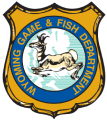Jackson Hole Elk Feedground: CWD Confirmation And Implications

Table of Contents
Understanding Chronic Wasting Disease (CWD)
What is CWD?
Chronic Wasting Disease (CWD) is a fatal, transmissible spongiform encephalopathy (TSE) affecting cervid species, including deer, elk, and moose. It's caused by a misfolded prion protein that damages the brain and nervous system, leading to progressive neurological dysfunction. The disease is insidious, with a long incubation period, meaning infected animals may appear healthy for months or even years before exhibiting symptoms.
- Prion disease: CWD is caused by misfolded prion proteins, unlike other diseases caused by bacteria or viruses.
- Neurological damage: The disease causes irreversible damage to the brain, leading to weight loss, behavioral changes, and eventually death.
- Symptoms: Symptoms include progressive weight loss, stumbling, drooling, and abnormal behavior.
- Incubation period: The time between infection and symptom onset can range from months to years.
- Transmission routes: CWD can spread through direct contact between animals, as well as indirectly through contaminated environments (soil, water, vegetation).
CWD's Impact on Elk Populations
The devastating effects of CWD on elk herds are well-documented. Infection leads to significant population declines due to increased mortality and reduced reproductive success.
- Mortality rates: CWD can cause high mortality rates within infected herds, significantly impacting population numbers.
- Reduced reproductive success: Infected elk often exhibit decreased fertility and reduced reproductive success.
- Weakened immune systems: The disease weakens the immune system, making elk more susceptible to other illnesses.
- Long-term population decline: Without effective management, CWD can lead to the long-term decline and even local extinction of elk populations.
The Jackson Hole Elk Feedground: A CWD Hotspot?
Concentrated Animal Populations
The Jackson Hole elk feedground, designed to help manage elk populations during harsh winters, ironically creates an environment highly conducive to CWD transmission. The artificial congregation of large numbers of elk significantly increases the risk of disease spread.
- Increased contact rates: High elk density leads to increased contact rates, facilitating the spread of CWD.
- Higher disease prevalence: Concentrated populations allow the disease to establish and spread more readily.
- Potential for environmental contamination: The feedground itself may become a reservoir of CWD prions, contaminating the environment and contributing to persistent transmission.
Management Challenges
Managing CWD in a concentrated setting like the feedground presents unique and significant challenges.
- Culling strategies: Culling infected animals is a common management strategy, but can be controversial and difficult to implement effectively in a large, wild population.
- Environmental decontamination: Decontaminating the feedground environment is extremely difficult and costly due to the persistence of prions in the soil.
- Surveillance challenges: Monitoring and testing a large elk population in a wild setting presents logistical hurdles.
- Public opposition: Control measures, such as culling or feedground closure, often face public opposition, hindering effective management.
Implications for Wildlife Management and Human Health
Spread to Wider Elk Populations
The potential for CWD to spread beyond the feedground to other elk herds in the region is a serious concern.
- Migration patterns: Elk migration patterns can facilitate the spread of CWD to new areas.
- Hunter-mediated spread: Hunter harvest and transportation of infected animals can inadvertently spread the disease.
- Environmental contamination: Contaminated environments can serve as reservoirs for the disease, leading to further spread.
- Impact on hunting regulations: CWD outbreaks can lead to restrictions on hunting seasons and regulations to manage the disease.
Human Health Concerns
While there is currently limited evidence of CWD transmission to humans, the potential risk warrants continued research and caution.
- Limited evidence of human transmission: To date, there is no definitive proof of human-to-human or animal-to-human transmission.
- Ongoing research: Research is ongoing to better understand the potential risk of human infection.
- Precautions for hunters and wildlife managers: Hunters and wildlife managers should take precautions, including proper handling and disposal of animal carcasses.
Future Management Strategies and Research Needs
Control and Mitigation
Effective management of CWD in Jackson Hole requires a multifaceted approach.
- Culling programs: Targeted culling of infected animals can help reduce the spread of the disease.
- Testing protocols: Improved testing methods are needed to accurately identify infected animals.
- Environmental remediation: Techniques for decontaminating the environment are under development.
- Feedground modifications or closure: Modifying or closing the feedground may be necessary to reduce disease transmission.
Research and Monitoring
Ongoing research and monitoring are vital for understanding CWD dynamics and developing effective management strategies.
- Disease surveillance: Continuous monitoring of CWD prevalence is crucial.
- Genetic studies: Understanding the genetics of CWD can help in developing control measures.
- Transmission studies: Further research is needed to fully understand the transmission dynamics of CWD.
- Development of vaccines or treatments: Research into potential vaccines or treatments is a long-term goal.
Conclusion:
The confirmation of CWD at the Jackson Hole elk feedground presents a significant challenge. Effective management of Jackson Hole Elk Feedground CWD requires a comprehensive and collaborative approach involving wildlife agencies, researchers, and the public. Proactive strategies are crucial to controlling the spread of this devastating disease and protecting both elk populations and human health. Learn more about the ongoing efforts to combat Jackson Hole Elk Feedground CWD by researching current updates from wildlife agencies and conservation organizations. Stay informed about this critical issue and contribute to the conservation of this valuable resource.

Featured Posts
-
 Third Straight Month Grocery Prices Outpace Inflation
May 22, 2025
Third Straight Month Grocery Prices Outpace Inflation
May 22, 2025 -
 New Olympic Swimming Venue Planned For Nice Details Of The Ambitious Project
May 22, 2025
New Olympic Swimming Venue Planned For Nice Details Of The Ambitious Project
May 22, 2025 -
 Peppa Pigs Real Name A Shocking Discovery For Fans
May 22, 2025
Peppa Pigs Real Name A Shocking Discovery For Fans
May 22, 2025 -
 Whats Next For Sydney Sweeney After Echo Valley And The Housemaid
May 22, 2025
Whats Next For Sydney Sweeney After Echo Valley And The Housemaid
May 22, 2025 -
 Taylor Swift And Blake Lively Navigating The It Ends With Us Legal Drama
May 22, 2025
Taylor Swift And Blake Lively Navigating The It Ends With Us Legal Drama
May 22, 2025
